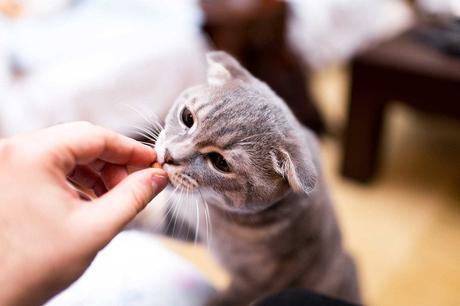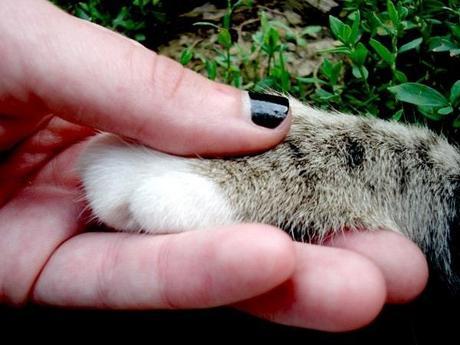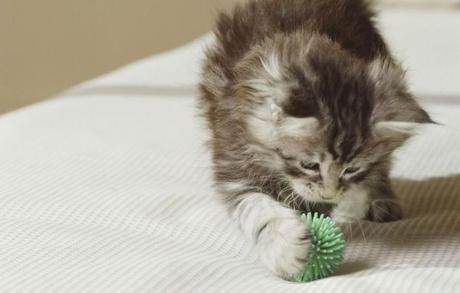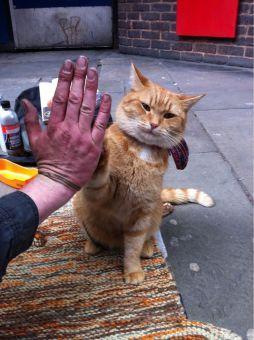Teaching tricks may seem unique to dogs and the occasional circus animal, but this is far from the truth! There are tons of animals in the world that are capable of learning how to perform tricks and to follow through with commands.

Top 10 cat tricks you can teach your cat by Rd
Our feline friends are an example of these types of animals. Cats may be seen as independent, sassy and even "lone wolf" type of creatures, but they are actually very sociable.
In fact, most house cats become intensely attached to their human family members and become completely dependent on their social interactions with them each day. Cats are also very intelligent creatures which is a very important quality to have for training purposes. Cat owners may have also realized how incredibly agile, crafty, and flexible their felines are.
These qualities make felines some of the most trainable animals not to mention some of the best performers! In this article, we will discuss (in further detail) whether or not cats can be taught tricks, why they are trainable, the best training methods for felines as well as the top 10 cat tricks!
Can you teach cat tricks?
As mentioned earlier, yes cats can be taught to do tricks. However, the discussion does not stop there! Cats can be taught certain behaviors which are useful to them and to us as their owners.

These behaviors include using the litter box to relieve themselves rather than going wherever they please, using a scratching post instead of the legs of your kitchen table, as well as when dinner time is instead of them being fed sporadically throughout the day without a standard routine.
These behaviors may seem mundane to non-cat owners but, to those of us that have owned cats in the past or are currently cat parents, these trainable behaviors make all the difference in the world!
Once a cat has been taught basic manners of being a house pet rather than a wild animal, he can be taught how to perform tricks that can be both useful as well as entertaining. It is important to mention that felines do not retain information in the same way humans or canines do. Therefore, it is unlikely that training methods that work for dogs would work on cats.
On the other hand, there have been reported cases of humans training their dogs how to perform tricks in front of their house cat and the house cat is able to perform the trick alongside the pooch. These cases do not always occur.
In fact, most of the time the cats that are being trained alongside their canine counterparts are members of a dog-like cat breed. Dog-like cat breeds (such as the Manx) have been known to perform tricks and follow through with commands from their humans just like a dog would. These felines will play a game of fetch, compete in agility courses and may even attempt to serve as protector of the household.
Why are cats so trainable?
As previously mentioned, cats are very intelligent, agile, and flexible pets that are very trainable. However, a quality that was not truly discussed is the loyalty that cats tend to have towards their human family members. You may think that loyalty is a unique trait to the family dog, but this is not so!

Cats become incredibly attached to their humans and are very loyal. This loyalty can be seen during training as the cats will often perform the trick or follow through with the command instructed to them by their owner simply to please them! So, when you take into consideration a feline's intelligence, agility, flexibility, and loyalty it is no wonder why cats are so trainable!
On the other hand, there may be a greater force that drives a cat to learn and ultimately perform tricks and commands. This force is commonly known as a kitty treat!
For many cat owners that are trying to train their feline, they may find that although their kitty is agile, friendly, loyal, intelligent and flexible, that nothing gets him moving more than a kitty treat. This is due to the fact that cats (like many of our household pets) would do nearly anything for food or treats. Even the most stubborn house cats may start to learn and perform their tricks and commands if their owner offers them a treat afterward.
What are the best cat tricks methods?
Not only can cats be trained to perform tricks or follow through with commands, but they should be!
Training your cat a few basic tricks and commands is an excellent way to keep them mentally stimulated. Mental stimulation for our furry family members is just as important as physical stimulation because it helps the animal live a well-rounded, happy, healthy and full life. The alternative is that the animal loses interest in even the most basic things that once made him so happy (i.e. bird watching, chasing an ant on the floor, or playing with a ball). Therefore, taking the time to teach your kitty a few tricks will not only entertain you and your family, but it will also benefit your feline.
So, what are the best training methods for cats?Well, the number one tip to training a feline is to start young. Otherwise, you may have an adult cat who has lost his motivation and therefore will be difficult (but not impossible) to train.

So, if you are starting to train your kitten then you will first need to find something (such as a treat or a favorite toy) to get his attention. Do not initiate play or the kitten may get confused as to the goal you are trying to accomplish. Once you have his attention, you are one step closer to successfully training your feline!
One of the best training methods for cats is using positive reinforcement. Cats and dogs are very similar in this way because neither of them responds well to discipline or negative punishment. Therefore, you should keep your eye out for a successfully performed trick or a command that has been followed through and then reward that trick, command, or behavior.
If you were given a cookie every time you completed your homework as a child, wouldn't you put more effort into completing it? It is a similar principle. Use rewards, not punishment!
Another great method to consider is to start simple. Do not immediately request your feline to give you a high five and expect him to do so simply because you asked him and are holding a bag of treats. Start by rewarding him for positive behaviors.
For example, every time he uses the litter box instead of the floor, give him a treat. Another example would be to reward him every time he chose to scratch the cat tree or scratching post instead of the legs of your kitchen table. By rewarding him for the good things and not for the bad things, he will start to perform the rewarded tasks more frequently and therefore stop the negative behavior.
Consistency and practice are also useful tools to keep in your training belt. Do not reward your cat for a behavior or a successfully performed trick one day and then ignore it or not reward it the next day. This lack of consistency will only confuse him. Make sure you follow through every time.
You should also keepa routine and practice frequently. You should not make the sessions too long or too frequent as your cat will either lose interest or forget why he is performing in the first place. Frequent training sessions (with treat rewards) can also become a health issue. Treats are loaded with additional calories and fats that should not become a staple in your cat's diet. Therefore, keep the training sessions short, consistent, and only scheduled for a few times a week (or a very short session each day).
The final method that you may want to consider when training your feline is switching from treat rewards to the clicker system. No, the clicker system is not just for training dogs. However, it is important to mention that not all cats will be receptive to the clicker method. It is a good system to instill in your cat as it does not add any calories or fats to your cat's diet. If you began by rewarding your feline with treats then you will have to slowly wean him off of them and get him used to the clicker as a reward. This could take quite a bit of time and patience from you.
Top 11 cat tricks to teach your kitten
Cat tricks #1 - Shake hands (or paws in his case)
Teaching your cat how to shake hands (paws) is more of an entertaining trick. Cats will not likely comprehend that this is the standard way to greet someone or introduce himself, but he could get used to shaking hands (or paws) with people as they enter the home, which would be quite entertaining for guests!
How to teaching your cat to shake hands
- Start by lifting your cat's paw. As a tip, this trick will be taught easier if you lift the same paw each time.
- As you lift and hold his paw, say "shake" and give him a treat. As a tip, try petting him after you let go of his paw. This will add positive reinforcement.
- Continue lifting his paw, saying "shake", giving him a treat, and then petting him for about five minutes each day. As a tip, choose a time of day that you are consistently home, not busy, and when your cat has not been fed as he will be more receptive to the treats.
- Eventually, you will be able to say "shake" and your cat will lift his paw on his own. Give him a treat and pet him for further positive reinforcement.
Cat tricks #2 -How to run an obstacle course
Teaching your cat how to run an obstacle course could come in handy if you plan on entering him into cat shows or if you simply want to use an obstacle course as both mental and physical stimulation.
- The first thing to remember when attempting this trick is that your feline is not a canine. Dogs typically have a nearly endless supply of energy and can be physically active for a good portion of the day without a nap. Cats are just the opposite. They typically have bursts of energy which allow them to be physically active for a short period of time and then they require a cat nap.
- Using a toy or treat, get your cat's attention and get him to follow you with it. Move about the house slowly, keeping his attention and keeping him following you to different locations around the house. If he does this successfully, give him a treat.
- Do this for short periods of time each day for about a week. Then, add in some obstacles that are in the room. For example, instead of simply walking across the floor, try stepping up onto the couch and hopping over it (carefully). If he follows you and successfully completes this task then give him a treat. Do this for a few minutes each day for about a week.
- Once your cat is used to following you around the house and up and over things in the home, you can start him on the agility course. Have him follow your hand with the treat or toy in it through the course. Give him the treat if he completes it successfully.
- Over time, he will be used to the course, the obstacles and following your hand throughout it. It is now that you can kick up the speed. If completed successfully, provide him a treat.
Cat tricks #3 - How to jump through hoops

Teaching your cat to jump through hoops is another trick that is more entertaining than it is beneficial. However, the higher your cat is able to jump through the hoop, the more physically active he is. Therefore, jumping through hoops can become a physical benefit as well as entertaining.
- Start by standing the hoop upwards on the ground. Hold a treat in your hand and when your cat walks through the hoop, give it to him, pet him and praise him.
- Continue this for a few minutes each day for about a week.
- Slowly raise the hoop off of the floor and continue to hold the treat on the opposite side until your cat hops through.
- Continue this routine for a few minutes each day. Each week the hoop should be raised further off of the ground until your cat is jumping through If your cat ever walks around or under the hoop to receive the treat then you should not give him the treat and you should start again or stop the session and resume it later.
Cat tricks #4 -How to jump (on command)
Teaching your cat how to jump on command might be more useful if taught to him prior to teaching him to jump through hoops. However, once he has learned one then he should have no problem learning the other.

- Start by getting your cat to focus on your hand that is holding a treat or a toy.
- Once your cat is focused and still, lower the treat close to his nose.
- Allow him to sniff the treat or toy and as he does, slowly raise it a little away from him.
- If he stands on his hind legs to follow it then he should be given a treat and be pet.
- Continue this process for a few minutes each day for about a week.
- The next week you should be able to speed up the raising of the toy or treat from his nose and say "jump" while doing so.
- If he stands on his hind legs faster, give him a treat. If he successfully completes the jumping motion, give him a treat.
- Over time you will be able to command him to "jump" and he will do so without following the treat or toy upwards. Once this happens he should be praised and given a treat.
Cat tricks #5 - How to sit down (on command)
Teaching your cat to sit down on command can be helpful if he likes to block the television, likes to walk on guests, or if you simply want to teach it to him.

- Begin in the same way as teaching him how to jump.
- Once your cat is focused on your hand with the toy or treat, say "sit" or "sit down" and gently push his bottom to the floor.
- Once he is seated, pet him and give him the treat.
- Repeat this for a few minutes each day.
- Eventually, you will not need to touch him to make him sit. Instead, you will simply command him to "sit" or "sit down" and he will do so. Each time he completes the task successfully as asked, pet him and give him a treat.
Cat tricks #6 - Teaching your cat to give kisses (on command)

Your cat may already give you kitty kisses throughout the day, but it could be very sweet and entertaining to get him to do so on command.
- Start by grabbing some baby food, yogurt, cream cheese, or another cat-friendly treat that is a similar consistency.
- Put a small portion of it on your finger or on your face.
- Once you have your cat's attention, point to the food on your finger or face and say "kiss." If he successfully completes the task then pet him and give him a treat.
- Continue doing this once or twice a day for about a week or until you can say "kiss" and he will kiss you without having any food on your finger or face.
Cat tricks #7 - Teaching your cat how to play fetch

This is another very entertaining trick that could also be used for physical exercise. Some catshave dog-like personalities and will, therefore, play fetch without being taught or will easily be taught how to play the game.
- Start by finding your cat's favorite toy.
- Then get your cat's attention and get him focused on the toy in your hand.
- Once you have his attention, throw the toy and say "fetch."
- If he chases after the toy, give him a treat.
- Pick up the toy and start again, repeating these steps. The tricky part for some owners is getting their cat to pick up the toy and return it to them. Some have found it helpful to put something tasty on it to entice the cat to put the toy in his mouth.
- Give your cat a treat if he chases the toy and picks it up in his mouth.
- Once he has it in his mouth, call for him to come back to you and if he does so with the toy in his mouth then praise him and give him a treat.
- Continue this for a few minutes each day until you are playing fetch with your cat!
Cat tricks #8 -Teaching your cat how to lay down (on command)
Teaching your cat how to lay down on command could be very beneficial if he is a fidgety, attention seeking cat, if he likes to walk over your guests' laps or if he is prone to begging for food.

- Start with a treat in hand and get your cat's attention.
- Once your cat is focused on your hand, say "lay down" and gently help him into a laying down position.
- You can also try rewarding him every time he lays down on his own. When you see your cat laying down, say "lay down" and give him a treat.
- Praise can also be beneficial for this trick, especially if you wait for him to lay down on his own.
Cat tricks #9 - How to stand up on his hind legs (on command)

Teaching your cat to stand up on his hind legs on command can be beneficial if you plan to teach him how to jump, jump through hoops or if you simply think it would be entertaining.
- Start with a treat in hand and get your cat's attention.
- Once you have your cat focused on your hand, put the treat close to his nose.
- Allow him to smell the treat and as he does, slowly raise the treat above his head and say "up".
- If he follows the treat upwards then reward him with the treat and praise.
- Repeat these steps for a few minutes each day.
- If he gets into the standing position, give him a treat.
Cat tricks #10 - How to give a high five
This trick is much easier to teach to your cat if you have already taught him most of the previously mentioned tricks. This is because he will be used to training sessions as well as following commands, both of which are typically the toughest parts for cats to get used to.

- Start with a treat, your cat focused and in the seated position. If he is not sitting, then command him to do so.
- Once your cat is focused on your hand, command him to "high five" as you touch lift his paw and touch it with your hand. (like a high five)
- If you have taught your kitty to "shake" already, then you may be able to teach the "high five" by altering the way your hand and his paw meet. Or, you can distinguish the two tricks by using the opposite hand (and opposite paw).
- Once your cat reaches out to your hand with his paw, give him a treat and praise him.
- Make sure you are saying the command "high five" to help him understand that he is not to "shake."

